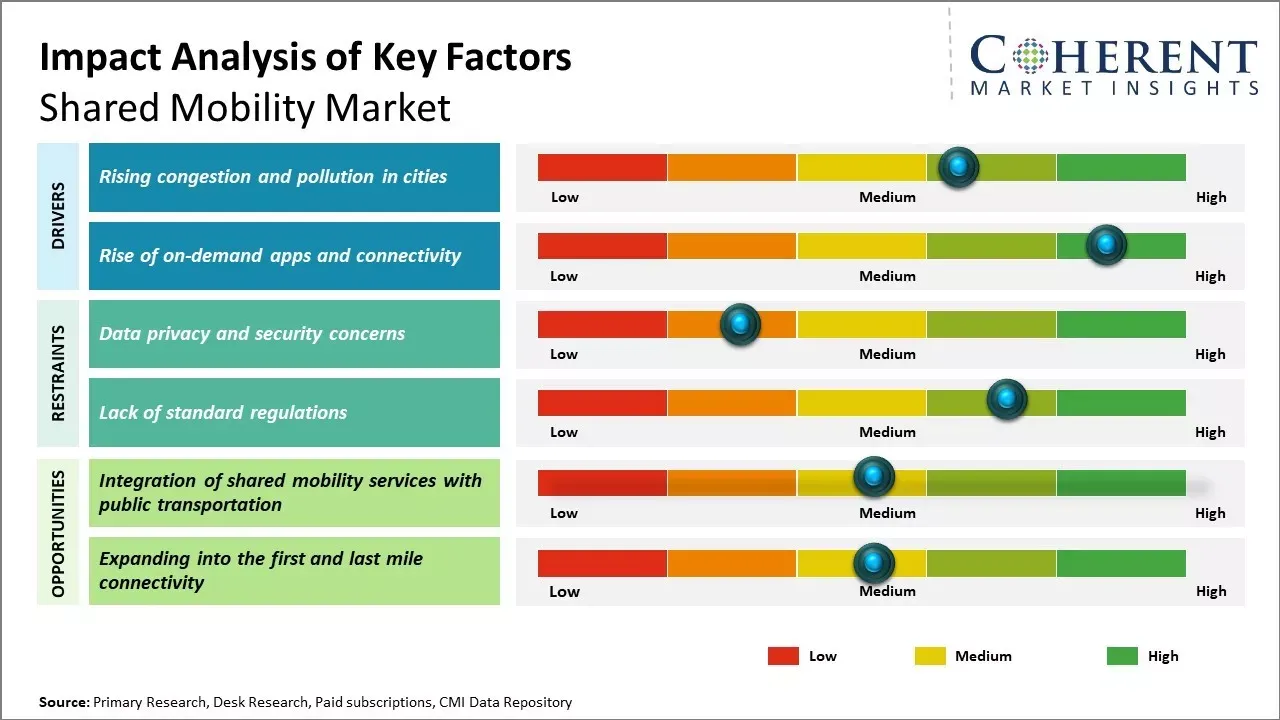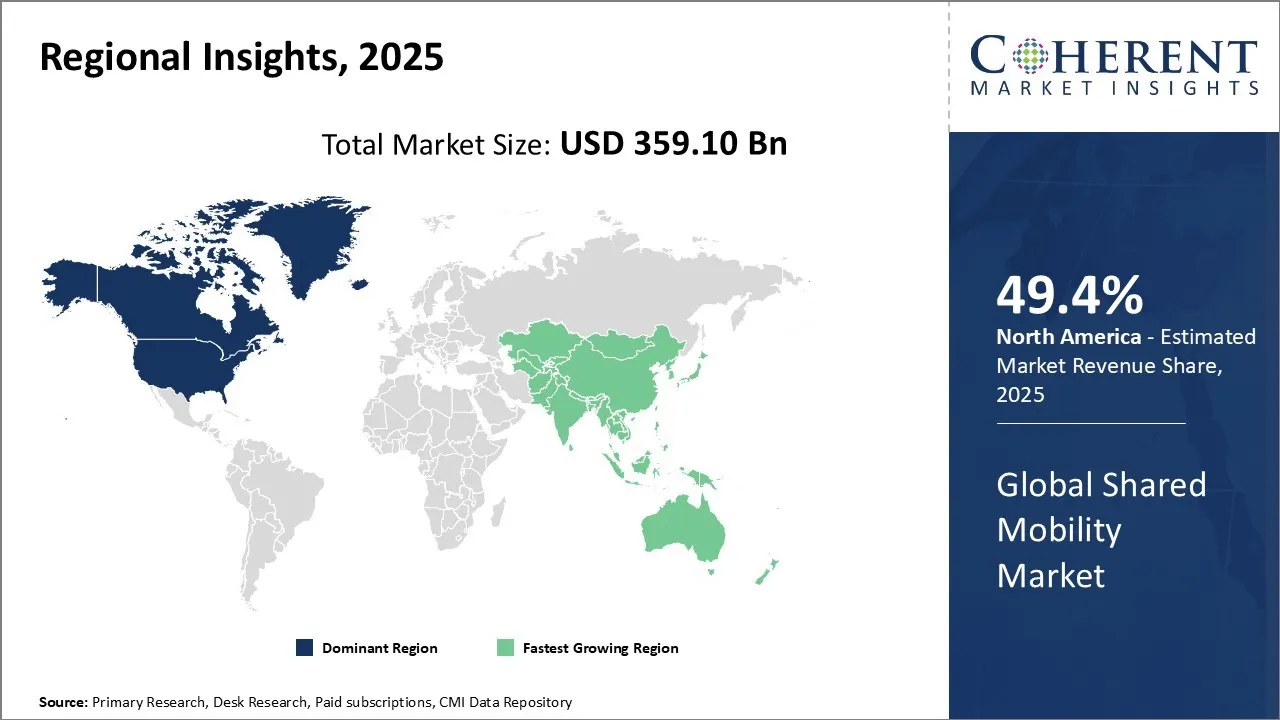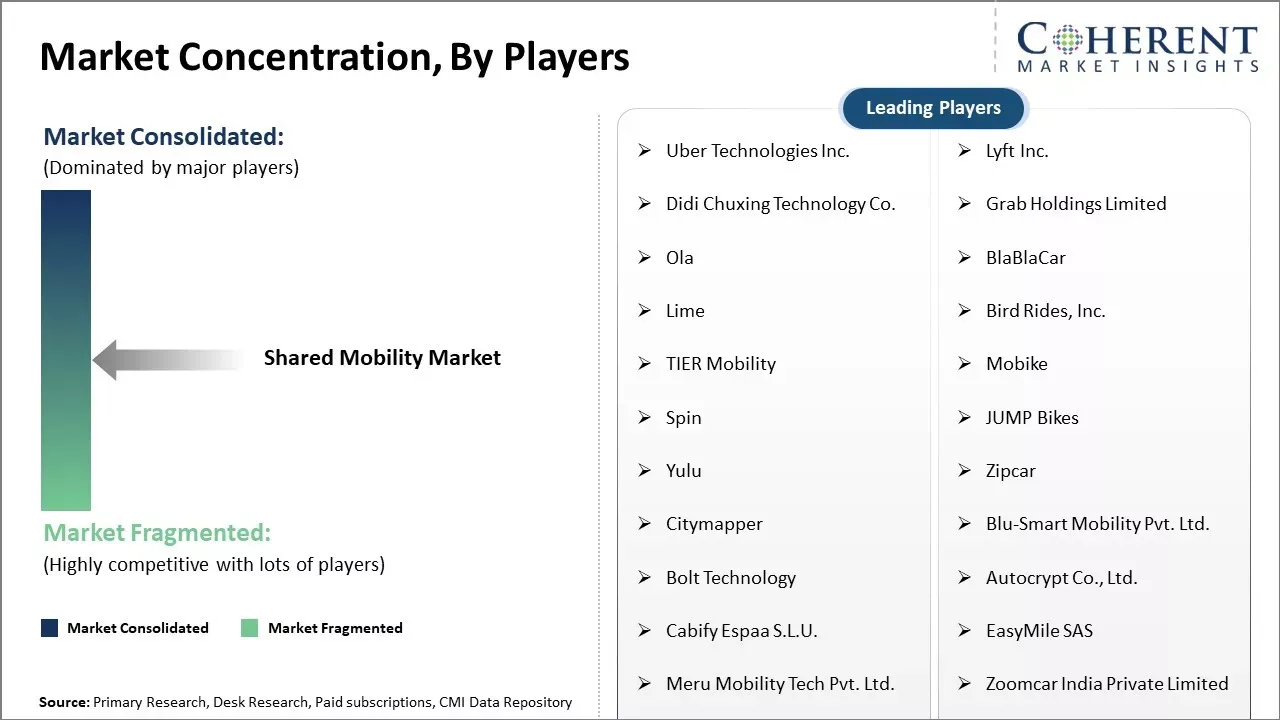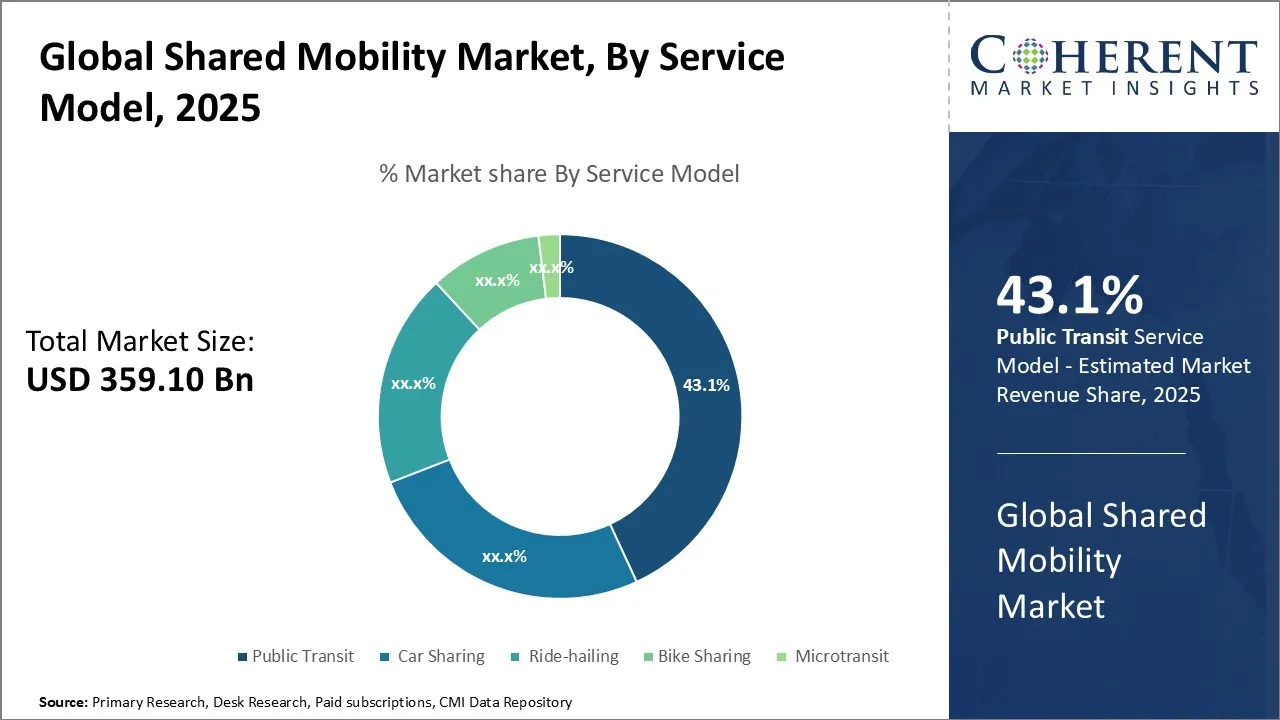Global Shared Mobility Market Size and Forecast – 2025 to 2032
The shared mobility market is estimated to be valued at USD 359.10 Bn in 2025 and is expected to reach USD 834.92 Bn by 2032, growing at a compound annual growth rate (CAGR) of 12.8% from 2025 to 2032.

To learn more about this report, Download Free Sample
Key Takeaways
- Based on Service Model, Public Transit segment is projected to account for 43. 1% of the global market in 2025, owing to its convenience and cost effectiveness for users.
- Based on Vehicle Type, the Passenger Cars segment is expected to capture the 37.5% share of the market in 2025, due to its popularity and versatility.
- Based on Sales Channel, the Online Sales segment is projected to command 71.5% share of the market in 2025, due to growing demand for smartphones and internet penetration.
- Based on Sector Type, the Unorganized segment is projected to command 76.5% share of the market in 2025, due to its ability to offer flexible and affordable transportation solutions.
- Based on Region, North America is set to dominate the global market with a 49.4% share in 2025.
Market Overview
The increasing preference for carpooling and ride-sharing services over private vehicle ownership, especially among the millennial population is driving the shared mobility market growth. The market trend in the shared mobility space has shown tremendous shift towards sustainability and environmental friendliness in recent years. Major players in this market have invested heavily in electric vehicles and infrastructure to provide emission-free transportation options to consumers who are increasingly demanding greener solutions. Shared mobility services allow higher vehicle utilization which reduces emissions overall.
Current Events and their Impact
|
Current Event |
Description and its Impact |
|
Global Electric Vehicle Transition and Battery Technology Advances |
|
|
Autonomous Vehicle Development and Regulatory Progress |
|
Uncover macros and micros vetted on 75+ parameters: Get instant access to report
Role of AI in the Global Shared Mobility Market
Artificial Intelligence (AI) is revolutionizing the global shared mobility market by enhancing operational efficiency, safety, and user experience. AI-powered systems enable dynamic fleet management, optimizing vehicle deployment and reducing wait times. For instance, AI algorithms analyze real-time traffic data to suggest the fastest and most fuel-efficient routes, improving overall service efficiency towards automotive. Additionally, predictive maintenance powered by AI helps in anticipating vehicle issues before they occur, minimizing downtime and ensuring a reliable service.
For instance, in May 2025, Pony AI Inc. and Uber Technologies, Inc announced a strategic partnership to deploy Pony.ai’s Robotaxis onto the Uber platform.
Shared Mobility Market Insights, By Service Model - Convenience and Cost Effectiveness Drive Growth in Public Transit
In terms of service model, public transit contributes the highest share of 43.1% in 2025 of the market owing to its convenience and cost effectiveness for users. Public transit allows individuals to travel within cities without the hassle and expense of owning and maintaining a private vehicle.
Commuters can rely on public buses, subways, and rail systems to take them where they need to go in an affordable manner. This makes public transit attractive for those seeking low-cost transportation options, such as students, elderly individuals, and low-income households.
Governments play a key supporting role through subsidies that keep fares low and services widely accessible. However, dedicated funding streams for continued system improvements and expansions will be needed to attract even more choice riders away from personal vehicles. Improving reliability, frequency and connectivity of routes across different modes can help boost ridership over time. If executed well, public transit offers a sustainable, shared solution for urban mobility demands.
For instance, in July 2025, the Maharashtra Metro Rail Corporation Limited (MahaMetro) expanded the network of shared autorickshaw service to three more stations. The initiative is part of MahaMetro's ongoing efforts to strengthen first and last mile connectivity for commuters. Such initiatives are proliferating the shared mobility market revenue.
Shared Mobility Market Insights, By Vehicle Type - Growing Adoption of Passenger Cars Drives Shared Mobility Market
In terms of vehicle type, passenger cars contribute the highest share of 37.5% in 2025 of the market due to their popularity and versatility. Cars provide flexibility for multi-passenger trips and transport of goods, making them highly suitable for shared mobility services.
The growth of transportation network companies (TNCs) that facilitate ride-hailing and car-sharing has increased vehicle utilization rates. Drivers are able to offer rides to additional passengers through TNC platforms, earning supplementary income from their personal cars.
Individuals also find shared cars advantageous over a private vehicle which avoids issues like high insurance costs, maintenance responsibilities, and fluctuating fuel prices. This has led to robust demand especially among the youth who see car-sharing as a preferable alternative.
Due to the inherent flexibility and profitability of the P2P structure, this business model has gained the most momentum in the shared mobility sector. Many transportation startups are now incorporating P2P components into their operations alongside fleet vehicles. So long as peer-to-peer marketplaces are able to address concerns around risk, insurance and verification, their domination of the shared goods and services space looks poised to continue.
For instance, in September 2025, Ride-hailing app Lyft and autonomous vehicle startup May Mobility announced to launch a pilot robotaxi service in Atlanta marking the partnership's first public deployment.
Shared Mobility Market Insights, By Sales Channel - Growing adoption of smartphones and internet connectivity are driving online sales channel
The online sales channel contributes the highest share of 71.5% in 2025 of the shared mobility market due to the increasing smartphone and internet penetration. As digital technologies become more widespread, consumers are shifting their purchasing habits to access services through mobile apps and websites on-the-go.
Ride-hailing giants in particular have optimized their mobile experiences and logistics to attract more customers to book rides directly from phones rather than hailing vehicles on the street. User-friendly app designs, easy sign-up processes, live tracking and driver details, integrated payment options, and loyalty programs encourage repeat use and trials of different shared modes that may not have been considered previously. Large numbers of new consumers who were not using shared fleets before have been drawn in by the appeal and practicality of arranging travel solely through intuitive digital tools.
In March 2025, Bolt and Volteum unveiled an online cost calculator designed to help ride-hailing drivers compare the expenses of electric vehicles (EVs) with their existing internal combustion engine (ICE) cars, providing a clearer picture of possible savings.
Shared Mobility Market Insights, By Sector Type - Unorganized sector is capitalizing on convenience and affordability
The unorganized sector accounts for the highest share of 76.5% in 2025 of the shared mobility market due to its ability to offer affordable, flexible transportation solutions tailored for local needs better than organized operators. Informal community-run services fill gaps not met by regulated fleets through personalized, on-demand arrangements outside of fixed schedules and routes.
Services like privately-owned taxis, three-wheelers, cycle rickshaws, auto-rickshaws, homestays, and informal car/bike pools operated by individuals or small groups provide highly accessible shared transportation that blends seamlessly into people's daily routines without impediments of formal procedures, membership programs or pre-booking requirements. Their impromptu, flexible nature lets travelers make quicker travel plans without being restricted to set timetables unlike organized public transit.
Additionally, unbranded shared vehicles are able to undercut prices of licensed commercial services thanks to lower overheads without infrastructure, licenses and security costs. This price competitiveness expands mobility access to lower income segments for whom even occasional use of app-based taxis may not be financially viable compared to familiar, nearby informal fleets.
Regional Insights

To learn more about this report, Download Free Sample
North America Shared Mobility Market Analysis and Trends
North America has emerged as the clear dominant player with 49.4% in 2025 in the global shared mobility market. The large presence of ridesharing giants like Uber and Lyft has transformed urban transportation across major cities in the United States and Canada. The early developments and high adoption of smartphone technologies provided a fertile ground for the growth of mobility-as-a-service platforms.
Additionally, American consumers have shown a strong preference towards flexible, on-demand transportation options compared to fixed schedules of public transit systems. This has enabled shared mobility services to achieve extremely high penetration rates in key metropolitan areas. However, companies now face challenges in smaller suburban and rural communities with lower population densities.
In September 2025, Kite Mobility, Canada’s leading provider of shared EVs for residential communities, unveiled its service at Tridel’s Auberge on the Park. Residents will have exclusive access to a shared Lexus RZ, Lexus’ first fully electric luxury SUV, blending sustainable transportation with premium convenience.
Asia Pacific Shared Mobility Market Analysis and Trends
The Asia Pacific region is poised to be the fastest growing shared mobility market going forward. Several factors contribute to the immense potential seen in this region. Urbanization levels are rising at an unprecedented pace with millions moving into cities across developing nations each year. This massive influx is straining existing infrastructure and traditional transit systems. As a result, shared mobility provides a highly cost-effective solution to this urban mobility problem.
Moreover, these rapidly developing economies are experiencing tremendous gains in disposable incomes. Combined with young demographic profiles, more people now have increased access to new mobility technologies.
Countries like China and India also offer a huge investment advantage with their large geographical sizes and consumer bases. Local entrepreneurs and international players have thus prioritized expanding operations and partnerships within Asia Pacific. If supportive policies are adopted, the region may surpass Western markets within the next decade.
For instance, in August 2025, AIC T-Hub, launched the fourth edition of its mobility accelerator programme, Charge, aimed at supporting 21 startups building solutions in electric mobility, shared transport, fleet management, and related technologies.
Shared Mobility Market Outlook Country-Wise
Canada Shared Mobility Market Trends
Canada’s shared mobility market is growing steadily, driven by increasing urbanization, shifting consumer preferences toward sustainability, and regulatory support for micromobility solutions. Ride‑hailing remains the largest revenue segment, with strong user penetration expected to continue growing in next decade.
For instance, in May 2025, the Transportation Association of Canada (TAC) released their Shared Micromobility Services in Canadian Communities report.
India Shared Mobility Market Trends
India is emerging as shared mobility hub owing to the 'Make in India' push by the government. To attract foreign direct investment, the government has eased policies for manufacturing units to set up shop locally. This has encouraged global automakers and tech giants like Uber to manufacture and assemble vehicles and fleet management systems at competitive prices to serve the Indian as well as exports markets.
Another boost is given through programs like 'Smart City Mission' that aims to develop sustainable and walkable urban infrastructure integrated with public transit solutions, making Indian cities more amenable for shared mobility networks to flourish. With initiatives under these schemes ongoing and yielding results it is clear India is ascending as Asia Pacific's most vibrant shared mobility marketplace.
For instance, in August 2024, the Gentari Go app has been launched in India by Gentari Green Mobility India, a company under the clean energy solutions group, Gentari.
Market Report Scope
Shared Mobility Market Report Coverage
| Report Coverage | Details | ||
|---|---|---|---|
| Base Year: | 2024 | Market Size in 2025: | USD 359.10 Bn |
| Historical Data for: | 2020 To 2024 | Forecast Period: | 2025 To 2032 |
| Forecast Period 2025 to 2032 CAGR: | 12.8% | 2032 Value Projection: | USD 834.92 Bn |
| Geographies covered: |
|
||
| Segments covered: |
|
||
| Companies covered: |
Uber Technologies Inc., Lyft Inc., Didi Chuxing Technology Co., Grab Holdings Limited, Ola , BlaBlaCar, Lime, Bird Rides, Inc., TIER Mobility, Mobike , Spin , JUMP Bikes , Yulu, Zipcar , Citymapper, Blu-Smart Mobility Pvt. Ltd., Bolt Technology, Autocrypt Co., Ltd., Cabify Espaa S.L.U., EasyMile SAS, Meru Mobility Tech Pvt. Ltd., Zoomcar India Private Limited, Getaround, Inc., Free2move, Lyft, Inc., and Yandex LLC |
||
| Growth Drivers: |
|
||
| Restraints & Challenges: |
|
||
Uncover macros and micros vetted on 75+ parameters: Get instant access to report
Market Trends
Rising Congestion and Pollution in Cities
With rapid urbanization and more vehicles on road, cities around the world are struggling with increased traffic congestion and deteriorating air quality. traffic congestion costs certain major cities hundreds of hours in lost productivity annually due to time wasted in traffic jams. At the same time, vehicular emissions are a major source of air pollution in most urban centers.
Nitrogen dioxide and particulate matter from vehicle exhaust are posing serious health risks. Shared mobility options are emerging as an effective way to reduce both these problems. When commuters switch to shared rides, bikes, or public transport, it results in fewer solo trips in private vehicles. This reduces the number of vehicles on road and helps ease traffic. It also curbs pollution as fewer vehicles mean lower emissions.
As emissions from a single shared vehicle are distributed across multiple passengers, the per person pollution comes down significantly. With growing public awareness about climate change and environment protection, more people are inclined towards choosing shared transport modes for daily commute which produce lower carbon footprint than private vehicles. For policymakers in cities, promotion of shared mobility becomes important from perspectives of managing congestion as well as achieving environmental and sustainability goals.
Rise of on-demand apps and connectivity
Advances in location-based technologies and connectivity have enabled the rise of digital platforms that connect drivers with passengers on-demand. Ride-hailing apps and peer-to-peer car sharing apps have made it extremely convenient to opt for shared mobility instead of owning a private vehicle. With just a few taps on the smartphone, commuters can now book a cab, shared rides, bike or scooter anytime, anywhere.
Companies providing these on-demand services ensure adequate availability of vehicles across city centers through fleet operations. Digital payment options further simplify the usage. The smartphone acts as a single interface to access different mobility services. As connectivity and app-based services continue spreading to smaller cities and towns, more people are experiencing the ease of shared transportation driven by technology.
Market Concentration and Competitive Landscape

To learn more about this report, Download Free Sample
Analyst Opinion (Expert Opinion)
- The shared mobility market is experiencing significant growth globally due to increasing urbanization and congestion in cities. Ride-hailing services such as Uber and Lyft have driven adoption of shared mobility as these services provides flexibility and convenience to users. However, vehicle ownership remains high in many markets which could restrain growth. Regulatory uncertainty also poses challenges as regulations vary widely across regions.
- North America has emerged as the dominant and fastest growing region for shared mobility market due to rising income levels, population density, and technology adoption in countries such as U.S. and Canada. Growing concerns over pollution level are further accelerating shared mobility solutions in major cities.
Global Shared Mobility Industry News
- In August 2025, Rapido, a ride hailing company, launched Hopr app, which is a car and bikepooling app for professionals that allow car or bike owners to offset fuel costs and offers commuters access to people living nearby them.
- In July 2023, Grab announced the acquisition of Trans-cab. The acquisition incorporates Trans-cab’s maintenance workshop, fuel pump operations, and car rental business. Additionally, the company will launch Grab Driver application, that would be integrated in mobile display units in Trans-cab taxis.
- In March 2023, Zipcar, Inc. launched the next phase of carshare program across the city of New York. The company’ carsharing services would be on the streets of Kew Gardens Hills in Queens, West Village in Manhattan, and Bedford Park in the Bronx
Market Segmentation
- Service Model Insights (Revenue, US$ Bn, 2020 - 2032)
- Bike Sharing
- Car Sharing
- Ride-hailing
- Public Transit
- Microtransit
- Vehicle Type Insights (Revenue, US$ Bn, 2020 - 2032)
- Passenger Cars
- LCVs
- Busses & Coaches
- Micro Mobility
- Business Model Insights (Revenue, US$ Bn, 2020 - 2032)
- P2P
- B2B
- B2C
- Sales Channel Insights (Revenue, US$ Bn, 2020 - 2032)
- Offline
- Online
- Sector Type Insights (Revenue, US$ Bn, 2020 - 2032)
- Unorganized
- Organized
- Regional Insights (Revenue, US$ Bn, 2020 - 2032)
- North America
- U.S.
- Canada
- Latin America
- Brazil
- Argentina
- Mexico
- Rest of Latin America
- Europe
- Germany
- U.K.
- France
- Italy
- Russia
- Rest of Europe
- Asia Pacific
- China
- India
- Japan
- Australia
- South Korea
- ASEAN
- Rest of Asia Pacific
- Middle East & Africa
- GCC Countries
- South Africa
- Rest of Middle East & Africa
- Key Players Insights
- Uber Technologies Inc.
- Lyft Inc.
- Didi Chuxing Technology Co.
- Grab Holdings Limited
- Ola
- BlaBlaCar
- Lime
- Bird Rides, Inc.
- TIER Mobility
- Mobike
- Spin
- JUMP Bikes
- Yulu
- Zipcar
- Citymapper
- Blu-Smart Mobility Pvt. Ltd.
- Bolt Technology
- Autocrypt Co., Ltd.
- Cabify Espaa S.L.U.
- EasyMile SAS
- Meru Mobility Tech Pvt. Ltd.
- Zoomcar India Private Limited
- Getaround, Inc.
- Free2move
- Lyft, Inc.
- Yandex LLC
Sources
Primary Research Interviews
- Shared mobility platform executives (Uber, Lyft, Didi Chuxing)
- Fleet management company representatives
- Urban transportation planners and city officials
- Automotive industry executives and mobility service providers
- Others
Databases
- International Transport Forum (ITF) Database
- McKinsey Mobility Database
- Deloitte Transportation Industry Database
- Bloomberg New Energy Finance (BNEF) Database
- Others
Magazines
- Automotive News
- Fleet Owner Magazine
- Smart Cities World
- Transportation Today
- Others
Journals
- Transportation Research Journal
- Journal of Public Transportation
- International Journal of Sustainable Transportation
- Others
Newspapers
- The Wall Street Journal
- Financial Times
- Reuters
- Bloomberg
- The Guardian
- Others
Associations
- Shared-Use Mobility Center (SUMC)
- International Association of Public Transport (UITP)
- National Association of City Transportation Officials (NACTO)
- Mobility as a Service Alliance
- Others
Public Domain Sources
- World Bank Open Data
- OECD Transport Statistics
- European Commission Transport Reports
- U.S. Department of Transportation Publications
- Others
Proprietary Elements
- CMI Data Analytics Tool
- Proprietary CMI Existing Repository of information for last 8 years
*Definition: The shared mobility market involves services that enable users to gain short-term access to transportation modes on an as-needed basis. This includes bike sharing, car sharing (renting cars for short periods of time, often by the hour), ride-sharing services (like Lyft and Uber), shuttle services, and other modes of transportation that are shared among users and owned by companies or individuals. These services aim to offer an alternative to private vehicle ownership, with users able to book different types of vehicles using mobile apps for short-distance.
Share
Share
About Author
Ankur Rai is a Research Consultant with over 5 years of experience in handling consulting and syndicated reports across diverse sectors. He manages consulting and market research projects centered on go-to-market strategy, opportunity analysis, competitive landscape, and market size estimation and forecasting. He also advises clients on identifying and targeting absolute opportunities to penetrate untapped markets.
Missing comfort of reading report in your local language? Find your preferred language :
Transform your Strategy with Exclusive Trending Reports :
Frequently Asked Questions
EXISTING CLIENTELE
Joining thousands of companies around the world committed to making the Excellent Business Solutions.
View All Our Clients

